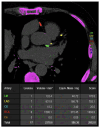Charting the Unseen: How Non-Invasive Imaging Could Redefine Cardiovascular Prevention
- PMID: 39195153
- PMCID: PMC11355021
- DOI: 10.3390/jcdd11080245
Charting the Unseen: How Non-Invasive Imaging Could Redefine Cardiovascular Prevention
Abstract
Cardiovascular diseases (CVDs) remain a major global health challenge, leading to significant morbidity and mortality while straining healthcare systems. Despite progress in medical treatments for CVDs, their increasing prevalence calls for a shift towards more effective prevention strategies. Traditional preventive approaches have centered around lifestyle changes, risk factors management, and medication. However, the integration of imaging methods offers a novel dimension in early disease detection, risk assessment, and ongoing monitoring of at-risk individuals. Imaging techniques such as supra-aortic trunks ultrasound, echocardiography, cardiac magnetic resonance, and coronary computed tomography angiography have broadened our understanding of the anatomical and functional aspects of cardiovascular health. These techniques enable personalized prevention strategies by providing detailed insights into the cardiac and vascular states, significantly enhancing our ability to combat the progression of CVDs. This review focuses on amalgamating current findings, technological innovations, and the impact of integrating advanced imaging modalities into cardiovascular risk prevention, aiming to offer a comprehensive perspective on their potential to transform preventive cardiology.
Keywords: cardiac resonance imaging; cardiovascular prevention; cardiovascular risk factors; coronary computed tomography angiography; echocardiography.
Conflict of interest statement
E. Ammirati received a grant from the Italian Ministry of Health (GR-2019-12368506), was principal investigator of the investigator-driven MYTHS (Myocarditis Therapy with Steroids trial), received a grant from Italian Ministry of Health and NextGenerationEU (PNRR-MAD- 2022-12376225), and received consultation fees from Kiniksa, Cytokinetics, and AstraZeneca.
Figures







Similar articles
-
The Role of Imaging in Cardiovascular Prevention: A Comprehensive Review.J Cardiovasc Echogr. 2025 Jan-Mar;35(1):8-18. doi: 10.4103/jcecho.jcecho_26_25. Epub 2025 Apr 30. J Cardiovasc Echogr. 2025. PMID: 40463756 Free PMC article. Review.
-
European Association of Cardiovascular Imaging/Cardiovascular Imaging Department of the Brazilian Society of Cardiology recommendations for the use of cardiac imaging to assess and follow patients after heart transplantation.Eur Heart J Cardiovasc Imaging. 2015 Sep;16(9):919-48. doi: 10.1093/ehjci/jev139. Epub 2015 Jul 2. Eur Heart J Cardiovasc Imaging. 2015. PMID: 26139361 Review.
-
Magnetic resonance imaging (MRI) for the assessment of myocardial viability: an evidence-based analysis.Ont Health Technol Assess Ser. 2010;10(15):1-45. Epub 2010 Jul 1. Ont Health Technol Assess Ser. 2010. PMID: 23074392 Free PMC article.
-
Positron emission tomography for the assessment of myocardial viability: an evidence-based analysis.Ont Health Technol Assess Ser. 2010;10(16):1-80. Epub 2010 Jul 1. Ont Health Technol Assess Ser. 2010. PMID: 23074393 Free PMC article.
-
Single photon emission computed tomography for the diagnosis of coronary artery disease: an evidence-based analysis.Ont Health Technol Assess Ser. 2010;10(8):1-64. Epub 2010 Jun 1. Ont Health Technol Assess Ser. 2010. PMID: 23074411 Free PMC article.
Cited by
-
Emerging Mechanisms and Biomarkers Associated with T-Cells and B-Cells in Autoimmune Disorders.Clin Rev Allergy Immunol. 2025 Feb 11;68(1):14. doi: 10.1007/s12016-025-09022-9. Clin Rev Allergy Immunol. 2025. PMID: 39932617 Review.
-
Lipid Accumulation Product Is Predictive of Cardiovascular Hospitalizations among Patients with Stable Ischemic Heart Disease: Long-Term Follow-Up of the LAERTES Study.J Cardiovasc Dev Dis. 2024 Oct 10;11(10):316. doi: 10.3390/jcdd11100316. J Cardiovasc Dev Dis. 2024. PMID: 39452286 Free PMC article.
-
Management of Acute Coronary Syndrome in Elderly Patients: A Narrative Review through Decisional Crossroads.J Clin Med. 2024 Oct 10;13(20):6034. doi: 10.3390/jcm13206034. J Clin Med. 2024. PMID: 39457985 Free PMC article. Review.
-
Smoking-Associated Changes in Gene Expression in Coronary Artery Disease Patients Using Matched Samples.Curr Issues Mol Biol. 2024 Dec 7;46(12):13893-13902. doi: 10.3390/cimb46120830. Curr Issues Mol Biol. 2024. PMID: 39727958 Free PMC article.
-
Unmasking the Silent Threat: Prevalence of Cardiovascular Risk Factors in MS Patients in Bucharest, Romania.J Clin Med. 2025 Mar 15;14(6):2001. doi: 10.3390/jcm14062001. J Clin Med. 2025. PMID: 40142809 Free PMC article.
References
-
- Perone F., Bernardi M., Redheuil A., Mafrica D., Conte E., Spadafora L., Ecarnot F., Tokgozoglu L., Santos-Gallego C.G., Kaiser S.E., et al. Role of Cardiovascular Imaging in Risk Assessment: Recent Advances, Gaps in Evidence, and Future Directions. J. Clin. Med. 2023;12:5563. doi: 10.3390/jcm12175563. - DOI - PMC - PubMed
Publication types
LinkOut - more resources
Full Text Sources

